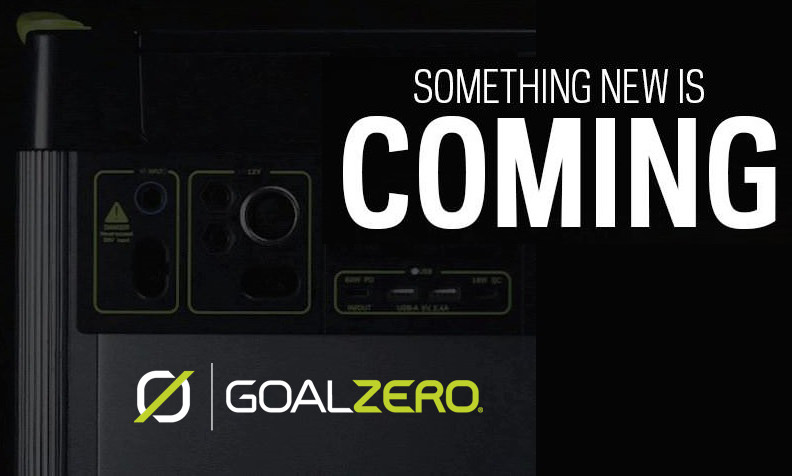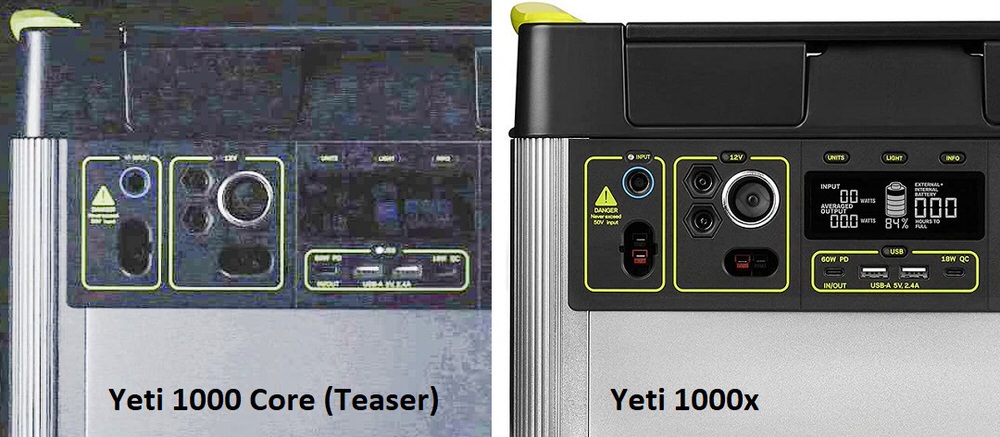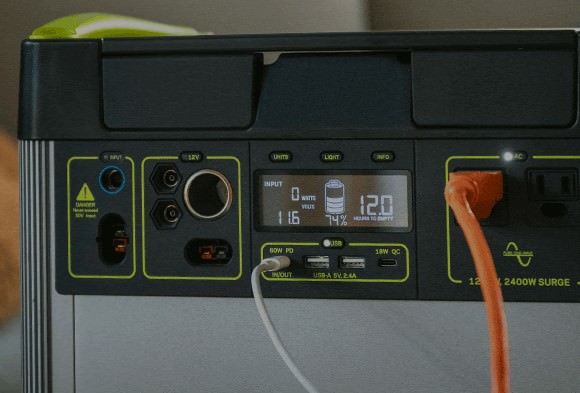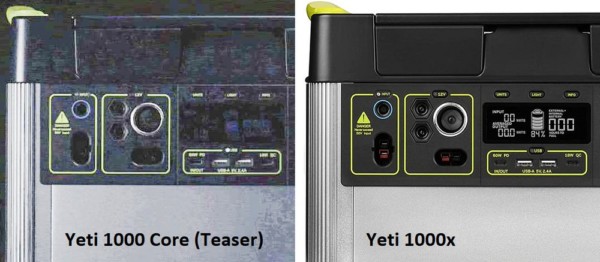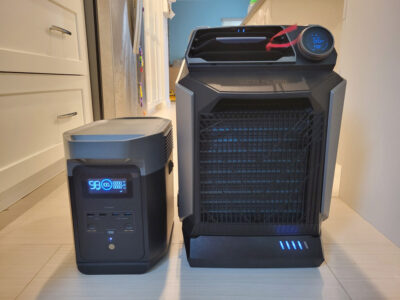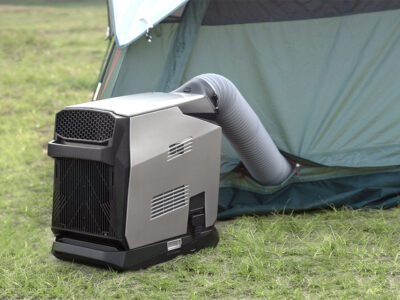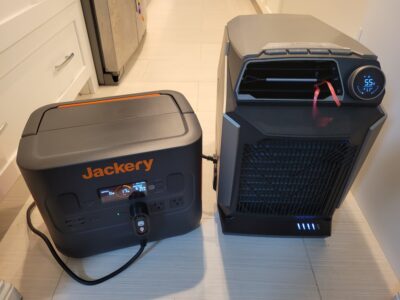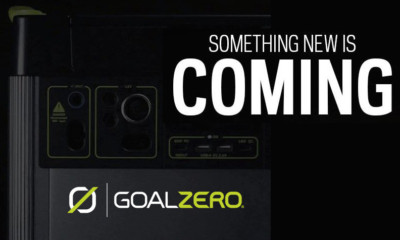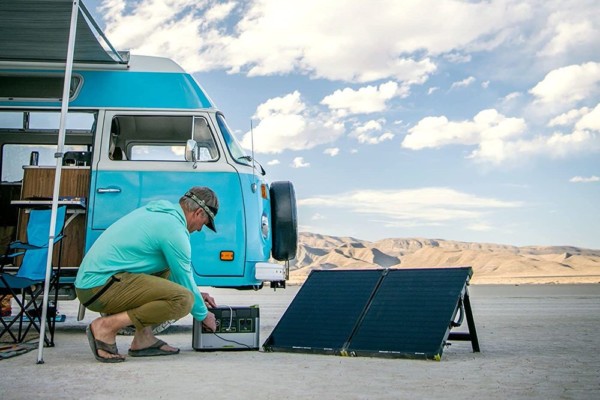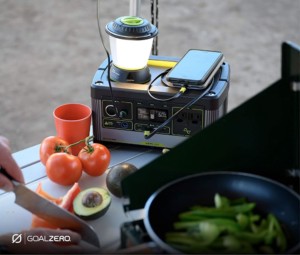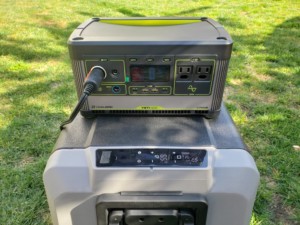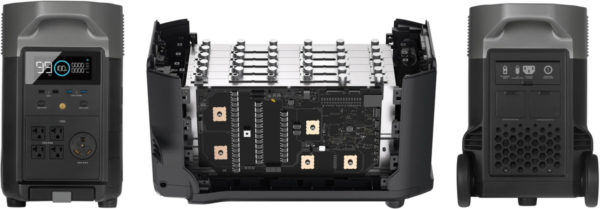Contents
The Teasers
Article updated 7/2/2021 with new details and mention of a “sweet deal” (pre-/launch discount). 7/15/2021 with a Tech Video detailing the Yeti 1000 Core’s features and specs, its Amazon listing and pricing, and how it compares to the Yeti 1000x and Jackery Explorer 1000.
This morning, Goal Zero sent an email about an upcoming, new product announcement. Specifically, it contained:
Email Teaser: “All the core features you’ve come to know and love from Goal Zero, at a price you’ll love too. Sign up below for an exclusive first look at our most streamlined power solution to date. Coming soon.”
Clicking on the email link took me to a Goal Zero Product Launch website that added some more details:
The image was followed with a countdown that puts the date on July 16, 2021:
Analysis
There was something very peculiar about the Goal Zero Product Launch web address that the email directed me to:
https://www.goalzero.com/product-features/product-launch/?
utm_campaign=063021_Yeti_1000Core_Upcoming_Product_Signup&
utm_content=touchpoint_1_message_b&
utm_medium=email&utm_source=zaius
You will see right there that a “Yeti 1000Core” is mentioned. I found that VERY interesting because the company had JUST launched its Goal Zero Yeti 1000x three weeks ago! Coincidentally, I had also JUST published my Yeti 1000x review two days ago! Why would the company be launching another 1000Wh (or, more unlikely, 1000W) power station?
How much energy a battery can store is measured in Wh (Watt-hours), and how much power is used or produced in W (Watts).
Side note: “Zaius” and “Touchpoint” in the above web address probably refer to the Zaius Customer Data Platform (CDP) that Goal Zero used to send out the email.
The key to why another 1000 Wh product may be launched may lie in the email: “All the core features you’ve come to know and love from Goal Zero, at a price you’ll love too.” Note the following keywords:
- “Core features” – as in “Core” in the product’s name: Yeti 1000 “Core”
- “Price”
The Yeti 1000 Core (“Yeti 1000Core” or “Yeti 1000c”?) appears to be a downsized, less expensive version of the Yeti 1000x.
It is unlikely that the Yeti 1000 Core will be better than the Yeti 1000x. But with a lower price, will Goal Zero’s newest product be popular for overlanding/boondocking, “RV/Van Life”, and/or emergency preparation?
Lower Pricing
What could Goal Zero possibly cut from the Yeti 1000x to lower the pricing for the Yeti 1000 Core? Let’s make some educated guesses. [Update 7/2/2021: In today’s email, there was a mention of a “sweet deal”, indicating that there may be a pre-launch/launch discount available.] [Update 7/16/2021: The new Yeti 1000 Core is exclusively available for purchase from Amazon for the launch price of $899. It will retail for $999.]
Battery
What we know is that the battery will likely be around 1000 Wh (probably 983 Wh like the Yeti 1000x). The company is known for its reliability and safety, and so I would be shocked to see them use a less expensive cell NOT manufactured by Tier 1 companies like LG, Samsung, Sanyo/Panasonic, or Sony. The Yeti 500x, 1000x, and 1500x all use LG batteries, and so my bet will be that the 1000c will also be LG. Jackery switched from LG/BAK Battery (on Explorer 1000) to EVE Battery with its Explorer 300, a move I was not too happy about as safety is very important when it comes to Lithium-ion cells. EVE is just not very well-known worldwide and its track record remains to be seen.
I also expect the Core to continue using Goal Zero’s Battery Management System (BMS) for safety, efficiency, and reliability.
The question I am not sure about is what battery technology will be used. Will the Core use Lithium-ion NMC like the Yeti X or will it house the older, heavier Lithium that the Yeti 1000 Lithium predecessor comes with? I strongly doubt that the heavy, expensive (but very safe) Lithium-ion LiFePO4 will be used. [Update 7/16/2021: Yeti 1000 Core uses LG-made Lithium-ion battery cells.]
Physical Dimensions
Will the Yeti 1000 Core use less expensive material than the 1000x? That is hard to tell from just looking at images, but what I did notice was how similar both products look after I enhanced the teaser photo found in the email:
I would have guessed that if Goal Zero was to release a lower-priced product, that support for the Yeti Link, Tank Expansion Batteries, Home Integration Kit, and Vehicle Integration Kit would be removed. That does not appear to be the case — unless the top compartment will just be an empty housing for storing cables and accessories, but that seems to be very unlikely. [Update 7/16/2021: Yeti 1000 Core does NOT have support for the Expansion modules.]
I do have to say (and sincerely wish that will come true) that the Yeti 1000 Core may be LIGHTER than the 1000x. Why? It’s a longshot, but the Goal Zero Switch 10 “Core” was touted as being “lightweight”. Yes, I know. That’s a really wild speculation on the “Core” naming, especially since the Switch 10 is a small product to begin with. However, if the Core will be using the older Lithium battery technology (instead of Yeti X’s Lithium-ion), then I expect the new product to be HEAVIER. [Update 7/16/2021: Yeti 1000 Core and 1000x share the same weight and dimensions.]
AC Inverter
An AC Inverter is responsible for converting DC (battery) power into AC — what you commonly see coming out of wall outlets. A very plausible scenario is for the company to provide a less powerful AC inverter with the Yeti 1000 Core. Let us consider the following table for the Yeti X product line:
| Product | Battery Capacity | AC Inverter (Continuous) | AC Inverter (Surge) | Max Input | Expandable | Charge Controller | WiFi, BT | Weight | Dimensions (inches) |
|---|---|---|---|---|---|---|---|---|---|
| Yeti 200x | 187Wh NMC | 120W | 200W | 120W | No | MPPT | No | 5 lbs | 7.9 x 5.1 x 5.1 |
| Yeti 500x | 505Wh NMC | 300W | 1,200W | 120W | No | MPPT | No | 12.9 lbs | 7.5 x 11.3 x 5.8 |
| Yeti 1000c | 983Wh NMC | 1,200W | 2,400W | 300W | No | MPPT | No | 31.7 lbs | 15.3 x 10.2 x 9.9 |
| Yeti 1000 Lithium | 1,045Wh NMC | 1,500W | 3,000W | 360W | Yes. Yeti Link, MPPT | PWM | No | 40 lbs | 15.3 x 10.1 x 9.3 |
| Yeti 1000x | 983Wh NMC | 1,500W | 3,000W | 600W | Yes. Yeti Link | MPPT | No | 31.7 lbs | 15.3 x 10.2 x 9.9 |
| Yeti 1500x | 1,516Wh NMC | 2,000W | 3,500W | 600W | Yes. Yeti Link | MPPT | WiFi, BT | 45.6 lbs | 15.3 x 10.2 x 10.4 |
| Yeti 3000x | 3,032Wh NMC | 2,000W | 3,500W | 600W | Yes. Yeti Link | MPPT | WiFi, BT | 69.8 lbs | 15.3 x 10.2 x 13.6 |
| Yeti 6000x | 6,010Wh NMC | 2,000W | 3,500W | 600W | Yes. Yeti Link | MPPT | WiFi, BT | 106 lbs | 15.3 x 10.1 x 17 |
How much energy a battery can store is measured in Wh (Watt-hours), and how much power is used or produced in W (Watts). A device’s power usage or a charging source’s output is rated in Watts (Amps x Voltage). See one of my battery power station reviews to learn more about Watts, Watt-hours, Continuous/Running and Peak/Surge outputs, and how to perform various calculations.
The Yeti 1000x appears to have the same inverter as its Yeti 1000 Lithium predecessor: 1,500W Continuous with 3,000W Peak.
The Peak rating determines how much power an AC inverter can handle when a connected device is powered on. The Continuous rating applies to devices that are already on/running. For example, a TV may temporarily suck up 700W (peak) when turned on, but only uses 200W (continuous) while in use.
The Yeti 500x only has a 300W Continuous and 1,200W Peak rating. Unless Goal Zero has developed a new AC inverter that would fall right between the 500x and 1000x, the 1000 Core will likely use the 500x’s. [Update 7/2/2021: A new image received in today’s marketing email more clearly shows the inverter with 2 AC outlets: 1,200W Continuous with 2,400W Peak. Nice!]
The Yeti 1000 Core will have an AC inverter that can handle 1,200W continuously and peak at 2,400W.
Goal Zero’s upcoming Yeti 1000 Core may ditch the 600W charging capability that the Yeti 1000x and larger siblings are capable of. That means that it may only be able to accept, like the older Yeti 1000 Lithium, up to 360W through its APP/HPP port (14-22V @ 30A max). [Update 7/15/2021: 1000 Core can accept up to 300W]
Note: Goal Zero renamed its Anderson Powerpole (APP) ports in Nov 2020 to High Power Port (HPP) to avoid trademark infringement with its inventor: Anderson Power Products. This is only a name change as the connector works the same way as before. For the purpose of avoiding confusion, I will interchangeably refer to the port as HPP or APP.
Charging Controller
A potential, cost-saving feature could be made with the charging controller technology used. Older Goal Zero products (like the Yeti 1000 Lithium) used the PWM (Pulse Width Modulation), whereas the Yeti X series now houses a built-in MPPT (Maximum Power Point Tracking).
The MPPT allows for smarter, faster, and more efficient solar charging, but also costs more than PWM. MPPT is best suited for larger power stations, and so it will be interesting to see whether the 1000 Core will include it. If it will not, I expect the Core to support adding an optional MPPT module the way the old Yeti 1000 Lithium did. [Update 7/15/2021: Yeti 1000 Core comes with a built-in MPPT!]
Retail Distribution
This may be a long shot of a guess: Yeti 1000 Core may only be sold directly from GoalZero.com. Hear me out on this one. When Goal Zero announces a new product, retail sites like B&H Photo, REI, and other, reputable sellers will usually have a product listing up and running weeks or months before its arrival. I could not find any information on the “Yeti 1000 Core” anywhere. That is VERY unusual.
Either Goal Zero has a really tight, non-disclosure agreement (NDA) with retailers or the company is going to sell the product directly. Why would that matter? By not selling the 1000 Core in brick and mortar stores, the company will effectively be able to cut down on distribution costs and pass those savings on to the consumer. Online selling is a different, potentially more cost-effective beast than retail. Just ask Jackery, Rockpals/Paxcess, BigBlue, and other brands that have primarily been selling online at lower prices than Goal Zero.
The Yeti 1000 Core may be an online-only product with distribution cost savings passed on to the consumer. [Update 7/16/2021: Yeti 1000 Core is exclusively available on Amazon for the launch price of $899. It will retail for $999.]
Expected Features
Features we could expect from the Goal Zero Yeti 1000 Core.
- Naming: Yeti 1000 Core, 1000Core, or 1000c
- Battery capacity: 983 Wh
- Chemistry: Lithium-ion NMC. Hopefully, it will not be the heavier, older Lithium used by the 1000x’s predecessor. Definitely will not be the more expensive, heavier Lithium-ion LiFePO4
- Sold directly to consumers via GoalZero.com or other online channels [Update 7/16/2021: 1000 Core is ONLY available on Amazon]
- A direct-to-consumer model bypasses some distribution costs that can help lower the product’s price
- Cost: $999 or $1,099 [Update 7/15/2021: Available on Amazon for launch price of $899! It will retail for $999]
- Goal Zero Yeti 1000x costs $1,299 / Yeti 1000 Lithium: $1,199
- Jackery Explorer 1000: $999
- New AC Inverter with Pure Sine Wave to allow sensitive electronics to be used
- Continuous output: 1,200W / Peak output: 2,400W
- PWM charging controller with option to add a Yeti Link MPPT module for more efficient solar charging [Update 7/15/2021: Yeti 1000 Core comes with a built-in MPPT!]
- Maximum charging (Input): 360W through the APP/HPP port (14-22V @ 30A max) [Update 7/15/2021: 1000 Core can accept up to 300W]
- Weight: 25-31 lbs [Update 7/16/2021: Yeti 1000 Core shares the same weight and dimensions as 1000x]
- Goal Zero Yeti 1000x is 31.7 lbs @ 15.3″ x 10.2″ x 9.9″
- Goal Zero Yeti 1000 Lithium is 40.0 lbs @ 15.3″ x 10.1″ x 9.3″
- Top quality batteries from LG with Goal Zero’s safe, reliable Battery Management System (BMS)
- The importance of using Tier 1 batteries cannot be stressed enough for the safe operation of a power station
- Same exterior design with fixed carry handles like the Yeti 1000x
- Will provide space to internally store cables and AC adapters
- May potentially allow Yeti expansion modules (like the MPPT charge controller) to be added, though it may also have support removed for the Yeti Link, Tank Expansion Battery, Home Integration Kit, and Vehicle Integration Kit to cut cost. [Update 7/16/2021: Yeti 1000 Core does NOT support the Expansion modules]
- Compatibility with Yeti Carry Case (Large) used by Yeti 1500x/1000x and Yeti 1400/1000 Lithium
Ports
- Input
- (1 or 2) 8mm (14-50V, max 10A) up to 150W [Update 7/15/2021: 1000 Core comes with two 8mm ports]
- (1) High Power Port (HPP aka Anderson/APP) for higher-input solar charging
- Up to 360W (14-22V @ 30A max) [Update 7/15/2021: 1000 Core can accept up to 300W]
- (1) USB-C PD 60W – Both for input/output
- Output
- (2) AC with 3 prongs (120V, 60Hz, 2.5A) – Pure Sine Wave
- (1) HPP (Anderson/APP) (12V, max 15A, max 180W) — Yeti 1500x maxes at 30A for 360W
- (1) Cigarette socket (12V, max 15A, max 180W)
- (2) 6mm (12V, max 10A, max 120W)
- Single, compact 12V port to universally charge electronics with different connectors using a variety of adapters
- Allows GZ to create 12V products to use 6mm instead of the bulky cigarette socket
- (1) USB-C PD (5-20V, max 3A, max 60W) – Both for input/output
- (2) USB-A (5V, max 2.4A, max 12W)
- (1) USB-C (5-12V, max 3A, max 18W) – QuickCharge
- (1) Expansion Module Port (in storage compartment) for use with GZ expansion modules
- This may not be included with the Core to cut cost
Portable Air Conditioner
The EcoFlow Wave is a portable air conditioner that accepts both AC and DC input. The company, of course, recommends using its own Delta power stations for better efficiency and longer runtime because they can draw directly from DC power. In a pinch, any battery or generator capable of providing the Wave-required input wattage could be used, but keep in mind that AC power loses some energy due to conversion to DC.
Final Thoughts
Based on my analysis, Goal Zero is readying a new product launch on July 16, 2021 with the Yeti 1000 Core (or 1000Core/ 1000c). It is likely going to be sold at a lower price than the recently-released, flagship Yeti 1000x with a slightly less powerful AC Inverter. The new power station appears to be physically similar in appearance as the 1000x and may be lighter with less expensive components used. However, I expect the Core to use the same, high-quality, LG-made battery cells and Battery Management System (BMS) as the Yeti X series for safety, efficiency, and reliability. Should the Core use the older Lithium battery technology instead of the Yeti X’s Lithium-ion, I expect the new product to be heavier. The 1000 Core may ditch the X’s built-in MPPT solar charging controller for the older, less efficient PWM module, but allow a separate MPPT module to be installed. Another likely, cost-cutting scenario is to remove support for the Yeti Link, Tank Expansion Battery, Home Integration Kit, and Vehicle Integration Kit offered with the Yeti 1000x. [Update 7/16/2021: Yeti 1000 Core comes with a built-in MPPT, does not support the Expansion modules, and is an Amazon-exclusive model.]
The lack of a product listing on retail sites may indicate that the Yeti 1000 Core will be sold directly by Goal Zero or other online stores with the supply-chain distribution cost savings passed on to the consumer. This would be a welcome move for those on the fence of buying Goal Zero products as this will position the company to better compete against less expensive competitors, like Jackery and Rockpals, who have primarily been selling directly to consumers via online stores. This very much reminds me of what SONOS did with its PLAY:1 speaker strategy: to introduce customers to less expensive models in hopes they will get a taste of what the company offers with its higher-end products.
Prior to buying the Yeti 1500x, I never fully understood why consumers would pay the higher prices of Goal Zero’s products when cheaper alternatives like Jackery and Rockpals existed. Sure, the company is known for their safety, reliability, and industry leadership, but what exactly could make them worth paying a premium for? I came to realize: Goal Zero has a large ecosystem of accessories, expansion modules, and integration kits that no other manufacturer has been able to offer. You could literally set up as small or as large of a system you need and expand upon it as your situation changes. For instance, I started with the small Yeti 500x (which has remained my favorite, lightweight power station), added a Jackery SolarSaga solar panel, and later got a Yeti 1500x. From there, I could expand it with 1-4 Yeti Tank Expansion Batteries and the Yeti Home Integration Kit to store my home’s excess solar output for emergencies when power was out. That made more sense to me than getting a LG or Tesla Powerwall that could only last about 10 years and could not easily be replaced. That design would also allow me to take the Yeti 1500x out for camping, move it to a new home, or use it in an RV/van should I choose to live a nomadic lifestyle at retirement.
I will be eagerly waiting to see what Goal Zero has in store with the Yeti 1000 Core, and I may be one of the first in line to get it and see how it compares to my friend’s Yeti 1000x. Let’s see if it will be compelling enough to get rid of my Jackery Explorer 1000 battery.
Where To Buy
- Goal Zero Products
- Yeti Power Stations
- 12V Car Charger (60W or 120W) (Goal Zero | Amazon)
- Solar Panels
- Cables (Goal Zero’s “HPP” is the same as “APP”)
- Yeti Link Expansion (See YouTube: Yeti Link + Tank)
- iGreely Extension Cables: 8mm / HPP (APP)
- Jackery Products
Related Posts
- Power Generators: Gas vs Propane vs Battery Station (and Solar)
- Ultimate Reference: Power Station Comparison
- EcoFlow Wave Portable Air Conditioner
- Reviews
- Goal Zero vs Jackery: Yeti 1000 Core vs 1000X vs Explorer 1000
- Goal Zero Yeti 1500x / Yeti 1000x / Yeti 500x
- Jackery Explorer 2000 Pro / Explorer 1000 / Explorer 300
- EcoFlow Delta Pro LiFePO4
- Bluetti EB70S LiFePO4
- BigBlue Cellpowa500 LiFePO4
- Rockpals 500W / nrgGo 400
- Quick Look
- Announcements
Other Useful Topics
Power Station Comparison
Check it out!
Ultimate Reference: Power Station Comparison – We summarized the specifications of many of the power stations we had come across or reviewed all in one place.
Gas/Propane Generators vs Battery Power Stations
In July 2020, I wrote about this topic after many asked what their differences were. In short, gas/propane generators can run virtually forever but are loud, dirty, and potentially quite dangerous. Battery power stations, on the other hand, are more portable, silent, less volatile, and can be operated indoor, but depend on external power (like solar) to recharge. Where gas/propane are used to GENERATE electricity, batteries STORE them for later use. Personally, I am a fan of the latter because they are so easy to carry around and are safer to use.
Who is Goal Zero (GZ)?
Going through the company’s history, the founder in 2007 started with a vision to help the poorest people of Congo get out of poverty. Their first product: the GoBe battery that now is the Yeti 150. Goal Zero was formed in 2009 with the mission to do good and provide “reliable power in the hands of every human being”. Its charitable arm had provided aid in areas struck by natural disasters.
Goal Zero’s portable power stations stand out in an increasingly competitive field with their unmatched safety record and use of quality components — and correspondingly high price tag. In fact, their Yeti 6000x with its 6,000Wh of energy (that could also be extended) was a powerhouse that not many competitors were able to safely provide at the time.
A friend of mine once said that GZ is “the best of the best” because of one simple reason: their vast ecosystem. I did not understand at the time what he meant, but as I learned more about the Yeti 1500x, my eyes were opened. The Yeti 1000x also taps into that same collection, but the Yeti 1000 Core does not.
Battery Technology and Safety
Goal Zero debuted with Lead-Acid batteries that were bulky and heavy. Today’s devices use Lithium-ion — commonly Nickel Manganese Cobalt (NCM) or Lithium Iron Phosphate (LiFePO4 / LFP) chemistries — for more power in a smaller, lighter package. NMC, however, is more volatile than LiFePO4 and becomes riskier as more cells are packed together. Goal Zero and Jackery used NMC for some time whereas EcoFlow and Bluetti use LiFePO4. Jackery launched its first LiFePO4 model in mid-June 2023 and Goal Zero in October that year.
- How much energy a battery can store is measured in Wh (Watt-hours), and how much power is used or produced in W (Watts)
- The higher the Watt-hour (Wh) capacity rating, the more dangerous the battery could become if not handled right
The quality of the battery cells and the BMS (Battery Management System) are crucial for safety.
Cell Manufacturers
Battery cells made by LG and Sony are among the best in the hobbyist world as are Sanyo/Panasonic and Samsung. Goal Zero uses LG. Jackery also uses LG or BAK (a leading Chinese brand). EcoFlow makes its own. During my years of research, I found that use of lower-quality batteries could pose a serious risk to life and property and should become a crucial part in deciding what to buy.
Safety
The second part in a battery’s safe operation depends heavily on the design and BMS (Battery Management System). Some BMS manufacturers, unfortunately, overstate their capabilities that could lead to catastrophic failure.
- Design should allow for proper, thermal cooling, use quality components, and obtain proper certifications
- Batteries made by known manufacturers are less likely to fail
- BMS should sufficiently restrict the battery from going past its capabilities
Li-ion: LiFePO4 vs NMC
There had been a lot of debate over whether Nickel Manganese Cobalt (NMC) or Lithium Iron Phosphate (LiFePO4) was better. Both are Lithium-ion batteries. Goal Zero, Jackery, and most of today’s power station manufacturers use NMC, but why do EcoFlow and Bluetti use LiFePO4 when they are bulkier and heavier? There are important distinctions, but the best battery is the one that meets all or most of your unique needs.
Charge Cycles
One of the most significant differences — and buying factors — is the charge cycle count for both battery chemistries. It measures how long the battery can be used for before it must be replaced or thrown away. LiFePO4’s count is as high as 4,000 cycles (as of 2023) whereas NMC is 500+. However, both have a useful life that can range between 3,000 – 5,000 cycles (even as much as 7,000 with proper care). But how does the count determine longevity?
Let’s look at Li-ion NMC as an example. It loses about 20-25% of total capacity after every 500 charge cycle. That means after the first 500 cycles, the battery drops 20% from when it was new, then another 20% after the next 500 cycles, and 20% again after that one. It would take roughly 1,500 charging cycles to have the battery last only half as long as when it was brand-new. Thus, it should be usable for 2,000+ cycles or about 6-10 years. Li-ion LiFePO4 can last longer.
CAUTION: Lithium-ion (LiFePO4 and NMC) batteries do NOT like to remain discharged at 0% for prolonged periods of time. If you let your battery stay at 0% for too long, you may not be able to charge it again without specialized equipment. Keep them at between 20-80% while in storage to maximize their lifetime.
LiFePO4 Advantages
- Safer, less volatile, and thus cheaper to manufacture
- Higher charge cycle: 1500-2000 (10+ years). NMC: 500+ (6-10 years)
- Usable in more extreme temperatures (-4F/-20C to 176F/80C). NMC: only 140F/60C max
- Holds 350-day charge. NMC: 300
NMC Advantages
- Smaller and lighter. Allows for more portable products
- Faster charging

